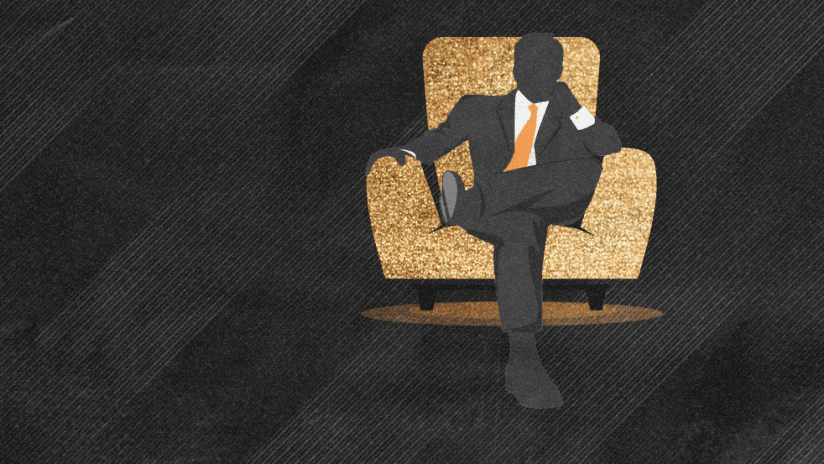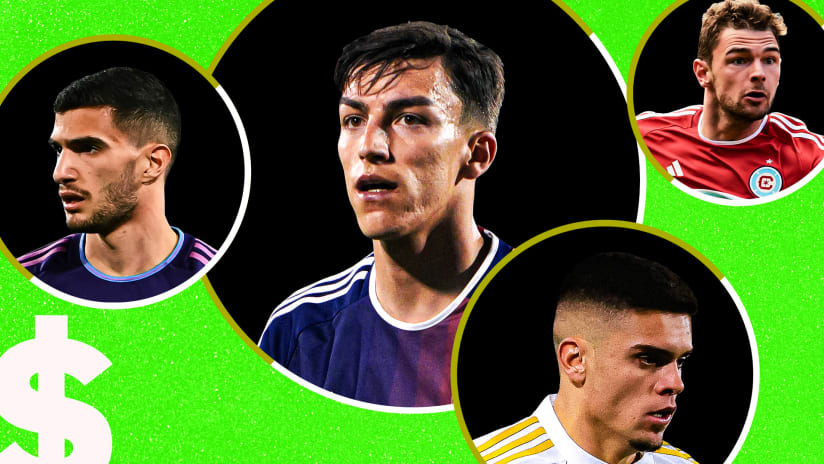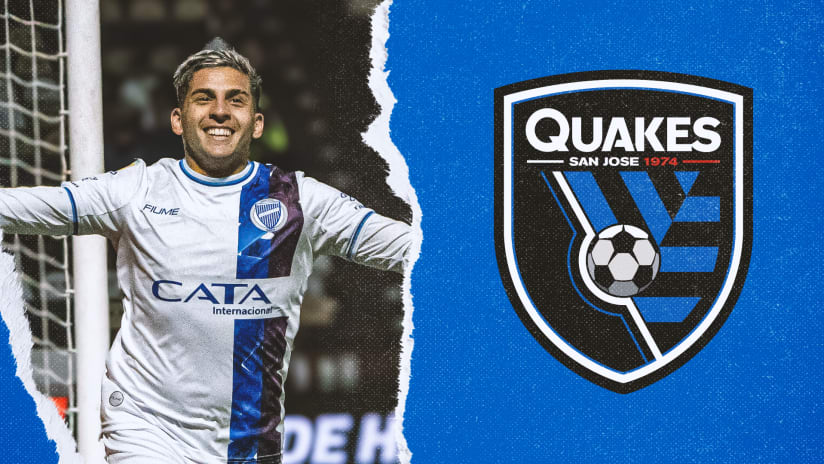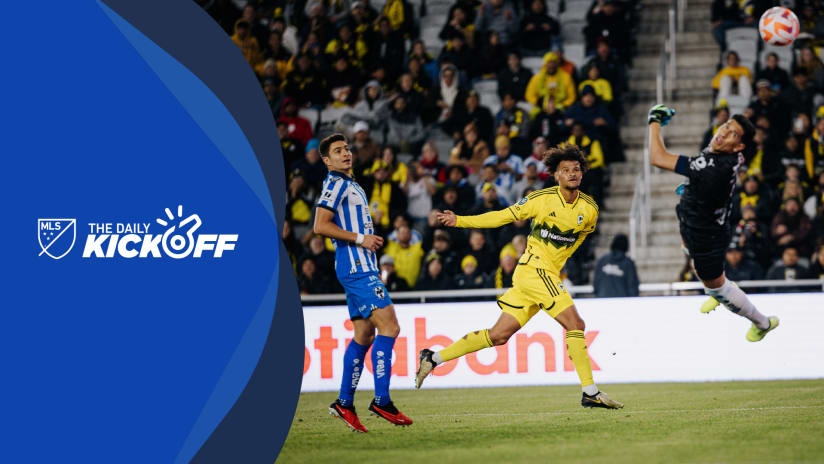There were two ideas, going back a dozen years now, on how to change the types of players that play in MLS. They were both good ideas.
The first one – the better-known one, the one that has brought this league players with names in neon lights, 12-feet-tall and luminous – was the Designated Player rule. You know this one because David Beckham was here, and Cuauhtemoc Blanco was here, and Thierry Henry was here, and Robbie Keane and Sebastian Giovinco and David Villa were here, and Zlatan Ibrahimovic, Wayne Rooney and Carlos Velaare here.
All of those names have meant something (some more than others, but still) both in North America and around the world. They brought fans, they brought credibility, they brought moments of glory:
The DP rule also brought players like Diego Valeri, Nicolas Lodeiro and Federico Higuain, great players whose names were neither quite so bright nor quite so big, but players whose names mean something here. It allowed MLS teams to keep players like Bradley Wright-Phillips, Tito Villalba and – hopefully – Luciano Acosta. It allowed an MLS team the ability to get Miguel Almiron at a record fee, and then sell him at a record profit, and maybe Alberth Elis or Diego Rossi is next.
It changed how MLS teams do business, and it changed how they won. Eight of the last nine MLS Cup champions (2013 Sporting KC are the only exception) had at least one significant DP, and most had two or three.
The rule worked. These are the players the casual fans ask about because they are the players whose names they recognize from the global game, and these are the players literally any soccer fan can appreciate because, well, what's not to enjoy about watching the likes of Henry or Higuain or most of the rest who've worn the DP tag well? DPs have been the face of the league since Beckham and Cuau landed here in 2007.
It's 2019 now, and the face of the league is changing. At least a little bit.
Back then, and for most of the rest of the time since then, the DP rule was the big one. The other rule, though, was the more important one because the best thing any league can do is make itself sustainable. The way to build a league that wouldn't just survive, but would actually thrive, was to invest the time and resources to create a the types of players who would someday display the type of quality that the DPs brought to MLS – players who'd command attention (from the biggest clubs in the world, mind you) on the global stage.
Thus in early 2008, six months after Beckham arrived and six months after the U.S. Soccer Development Academy (USSDA) initiative was launched, MLS unveiled the Homegrown Player rule. And so would begin an often glacially slow, but completely necessary evolution as to what the league is, what it could be, and who's driving it there.
With that in mind, here are the regular season goals/assists/minutes totals of teenaged American attackers in each of the last four seasons:
- 2016: Three players (Caleb Calvert, Coy Craft and Bradford Jamieson IV) combined for 0g/0a in 221 minutes
- 2017: Seven players (Jonathan Lewis, Pierre Da Silva, Brandon Vazquez, Djordje Mihailovic, Paxton Pomykal, Jesus Ferreira) combined for 5g/4a in 1416 minutes
- 2018: Twelve players (Mihailovic, Mason Toye, Vazquez, Isaac Angking, Shaft Brewer, Ayo Akinola, Anthony Fontana, Pomykal, Ben Mines, Andrew Carleton, Ferreira, Gianluca Busio) combined for 4g/8a in 1749 minutes
Bear in mind that's the entire regular season for each of those calendar years.
Now here's what we've seen from just one month of the current season:
- 2019: Twelve players (Justin Rennicks, Fontana, Pomykal, Akinola, Carleton, Frankie Amaya, Brenden Aaronson, Ferreira, Luis Arriaga, Thomas Roberts, Busio, Efrain Alvarez) have combined for 6g/5a in 1185 minutes
While this has been happening with US products in MLS, a pair of Canadian attacking players – Ballou Jean-Yves Tabla and Alphonso Davies – have been sold for multiple millions of dollars to Barcelona and Bayern Munich respectively.
For further context: In the Bundesliga this season, nine teenaged domestic attackers have played. In the EPL it's 12 teenaged English attackers, and in Italy it's 11 Italian teenagers who've seen the field (all this data gleaned via Transfermarkt). MLS kept their company last year, and this year the league is headed toward the likes of the Eredivisie, France's Ligue 1 and the Argentine Primera.
It's like a switch got flipped and this past month, after years of flickering, the lights finally came on. MLS is a different league in 2019.
Every single one of those players listed above got at least some run in a USSDA program, and the vast majority are Homegrowns. They are not, en masse, displacing DPs or even Targeted Allocation Money caliber players yet, but some of them are, to the point that it's stunning how much of a shift there's been in who's playing attacking minutes so far in 2019.
There are a few things at play here. First is that there's simply better coaching at the youth level now than there was five years ago, and much better five years ago than five or 10 years before that. The USSDA and MLS academies played a significant (I'd argue the significant, but nobody can really quantify that) role in making this so.
And while there are only a select few MLS academies that can truly be considered amongst the world's elite, the qualifier is the accomplishment: There are a few MLS academies that are considered amongst the world's elite. Those kids are now matriculating into real minutes.
Second is that these kids – really the '99s and younger – didn't grow up outside of the world's game and then get introduced to it. Between USSDA and the world of 24/7 soccer coverage, they were born into it, and there's no better illustration of that than the sheer volume of professional, top-flight No. 10s produced at various age groups:
'96: Emerson Hyndman
'97: Jackson Yueill
'98: Mihailovic
'99: Pomykal
'00: Carleton, Amaya, Aaronson
'01: Arriaga, Roberts
'02: Busio, Alvarez
Notice a trend? In the words of a friend of mine who's worked with top youth players at top clubs both in the US and Europe, "A lot of those kids would have been developed as mediocre No. 8s five years ago." Now, because of the way they're being exposed to the game (and trained for the pro game) at a young age, they're mostly getting to sink or swim in their best spots.
Which means it's time to circle back a few paragraphs and realize the final point: There's been considerable resources invested in these young players – of the teenaged domestics who've played this year, only Amaya is not a Homegrown (he was the No. 1 pick in the SuperDraft). Teams have put a lot on the line to try to make great players, and more and more MLS coaches are 1) honoring that investment by trusting those kids with MLS minutes, and 2) adopting an "if you're good enough, you're old enough" approach.
So pay attention to the likes of Rooney, Vela and Alejandro Pozuelo, especially this week. They're here and they've made this league a lot better.
But pay attention to what else is happening now because it should give you an idea of what's coming next – and where it's coming from.
(Ed. Note: Doyle should have mentioned that you will be able to see the next crop of young American attackers at the Generation adidas Cup in a couple weeks. Players like Alvarez, Busio, Aaronson and Pomykal all starred at that tournament in the past and this year you could see players like Griffin Yow, Dante Sealy and Gilbert Fuentes take up the mantle. -Ben Baer)
A few more things to ponder...
12. Pozuelo's debut was legendary, as he led Toronto FC to a 4-0 demolition of reeling NYCFC. The Reds' ability to just pass through the Cityzens was reminiscent of their 2017 heyday:
(feel free to laugh at the fact that I switched to the wrong camera at the end of that clip – cringe – but the sentiment is correct)
Pozuelo looks like he's going to be a filthy amount of fun.
NYCFC have four wins in their past 20 across all competitions, and their weekly adjustments have paid zero dividends. Their captain and best player, midfield Alex Ring, called it an "inexcusable performance," and he's not wrong. They don't seem to keep their shape well, and they don't seem to get pressure to the ball well, and they're no longer good enough in possession to just defend that way for 65% of the game.
11. Chicago finally got their first win of the season, 1-0 over the Red Bulls courtesy of a Tim Parker own goal.
It was a super-ugly game, as RBNY games often are. The Fire had just 35 percent possession, and completed just 60 percent of their passes (both numbers are very low). But they were able to effectively muck up the midfield playing out of a 4-2-3-1 with Bastian Schweinsteiger at center back.
If RBNY aren't going to win the rock fight in midfield then they've got to break teams down, and so far they've been unable to manage it. Against Atletico Pantoja (a semi-pro team from the Dominican Republic) they're 2-0-0 in 2019; against everyone else they're 1-4-1 with a -3 goal differential.
Nobody should be panicking in Harrison, but they've got to rediscover their identity or they can kiss hopes of homefield advantage goodbye.
10. The one RBNY win was against the Quakes, who won last year's Wooden Spoon and have begun 2019 by plumbing new depths. They lost 5-0 at home on Saturday afternoon to LAFC, have zero points from four games, are at a -12 goal differential already and are on track to concede 119 goals over the course of the season. Head coach Matias Almeyda gave us our Face of the Week:
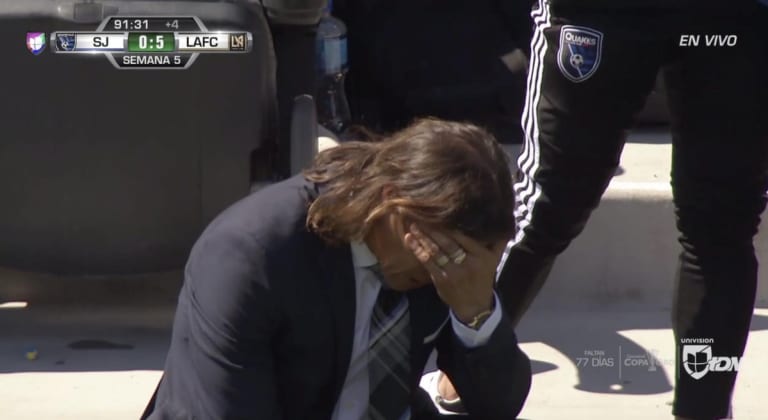
He says he will not change his formation or tactical approach.
LAFC are very good, and it felt like they wanted to send a message a month after a testy and physical preseason encounter that saw LAFC lose 3-0.
“It’s a real good reminder of the fact that different teams in the league have different ideas of how to play," Bradley said then. "When you come up against a team that is very committed, you have to be able to match them. Today they were better at playing their way than we were at ours.”
Preseason matters.
9. San Jose weren't even the weekend's biggest losers, as Montreal did them one better by going to Sporting and losing 7-1. I'm not entirely giving them a mulligan, but it should be noted that they were playing without Ignacio Piatti and Zakaria Diallo, who are probably their two most important players.
I mean, it wouldn't have mattered though, right? Sporting were rested and fielded all their starters, and so far this season when they check those two boxes they're the best team in the league.
8. All hail the Revs! They felt enough pressure to put together a 2-1 home win over Minnesota United FC in a performance that was short on aesthetics but long on scrappiness. Carles Gil continues to look worth the price, and Brad Friedel was justifiably happy with the effort of the players.
The Loons have dropped two straight and Adrian Heath's Week 2 rant is starting to look at least a little bit premature. They have one more roadie (at RBNY next weekend) before they open up their gorgeous new stadium.
7. Columbusthumped Atlanta 2-0 in torrential rains in central Ohio on Saturday evening. Things are not great for Atlanta, who finished the month winless and at the bottom of the Eastern Conference:
I feel like every single week I can come up with a new stat that encapsulates at least some of Atlanta's regression from last year. This week's stat: Their average shot distance in 2019 is 20 yards, while in 2018 it was 17.5.
And here's a weird: When Atlanta beat Monterrey 1-0 a few weeks ago in the second leg of their CCL quarterfinal, it looked like they'd finally figured out De Boer's 3-4-3. In their two outings since then, they've moved to a 4-2-3-1 and look very much like they're learning a new system in a new formation.
Why change after a pretty decent win?
Caleb Porter, meanwhile, continues to look very smart for not changing up all that much of Gregg Berhalter's system. Gyasi Zardes keeps getting looks in the box and keeps finishing them, the defense keeps holding firm and the midfield keeps humming along.
6. Southwestern Ohio got soaked, too, and with the rains came the end of FC Cincinnati's winning streak as the visiting Philadelphia Unionwon 2-0 behind another pretty excellent performance from the rejuvenated David Accam.
A week after shifting back to the 4-2-3-1, Jim Curtin had his team move back to the 4-4-2 diamond, which was crazily symmetrical:
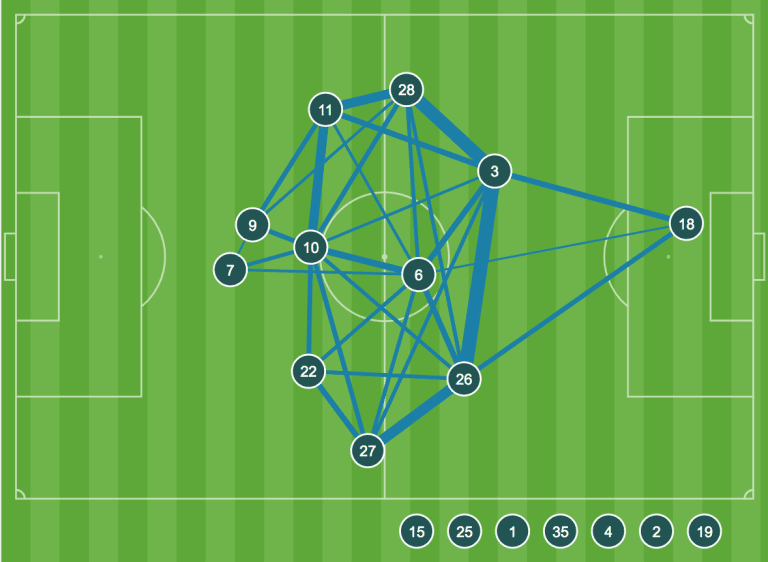
That's a network passing map made using Opta data. Each circle represents the location of the corresponding player's aggregate touch, while the thickness of the lines connecting them represents the volume of passes exchanged.
Accam (No. 7) has mostly been on the wing in his MLS career, but looked very much at home playing as a hyper-mobile forward alongside Fafa Picault, who's probably the league's best pressing forward. It'll be interesting to see how they hold up next week against an FC Dallas team that's much better playing through the lines from the back.
5. Colorado also played a diamond, and kept it super narrow against Houston. Which was suicide, because that basically gave Elis a running start every time he touched the ball – which was a lot in what eventually became a 4-1 Dynamo win.
“I think the biggest problem for us was the start of the game, again. The reality is we didn’t deal with their dangerous players – Elis," is what head coach Anthony Hudson said after the game. "We were far too passive in the first half and put ourselves in a hole. At halftime we have to say a few words and then we get a reaction and we were far better in the second half. But overall it’s not good enough.”
Watch that from the start once or twice. Notice anything?
Yeah, one pass up the gut cut out the whole Rapids midfield, and none of them ever got back into the play. Elis and Memo Rodriguez tormented the Rapids fullbacks, but the truth is this game was lost all over the whole field. It was brutal.
The Dynamo should be very happy as they handled a relatively gentle March schedule with some aplomb.
4. As I tweeted on Saturday night in the midst of Vancouver's scoreless draw against the visiting Sounders, I'm impressed with Marc Dos Santos and think he's going to prove to be a good MLS coach. Their overall team shape and clarity of defensive roles when dealing with what had been, to this point in the season, an overwhelming Sounders overload down the left got them the shutout. And then they were prepared to identify when and how to break as opportunities presented themselves.
They actually won the expected goals battle by a very marginal amount, 1.18 to 1.08, and if Stefan Frei didn't produce a couple of top-tier saves the 'Caps would've had all three points.
The Sounders are still really good – one of the apex predators in the league. But man do they take chances in transition.
3. D.C. United scored on each of their first two shots, which came in the first half hour. They then held on for dear life over the next 60 minutes and only just came away from Orlando City with a 2-1 win. Rooney had a (spectacular) goal and an assist.
The Lions scrapped and fought and looked nothing like the bunch that just sort of quit for the final two-thirds of last season. But they have made a habit of early and catastrophic lapses at the back, which defined this game.
I have no idea why Chris Mueller doesn't start every week, by the way.
2. Portland put together what I thought was their best performance of the year, switching to a 5-3-2 and clogging up the middle in order to shove the Galaxy to the flanks. But Zlatan is Zlatan and a PK is a PK, and that's how you lose 2-1.
Despite the scoreline I bet the Timbers ride the five-at-the-back look.
Despite the scoreline I thought LA played worse than last week. Part of that is credit to the Timbers, but at the same time LA have too much talent to settle for 28 mostly useless crosses. The free-flowing soccer they put on display two weeks ago against Minnesota United was nowhere to be found in this one.
1. And finally, our Pass of the Week goes to one of the kids. Jesus Ferreira is the son of 2010 MLS MVP and Colombian national team player David Ferreira, who was a true No. 10. Jesus is not that – he's more of a fox-in-the-box No. 9 who can moonlight on the wing.
On this particular play, though, he was operating in his old man's neighborhood:
That's Jesus pulling off the front line, confusing the RSL defense and then slipping Michael Barrios through before Barrios sets up Carlos Gruezo for the tap-in. Lovely little sequence from FCD, who won 4-2 in Utah.
RSL now have four points and four red cards from five games.


